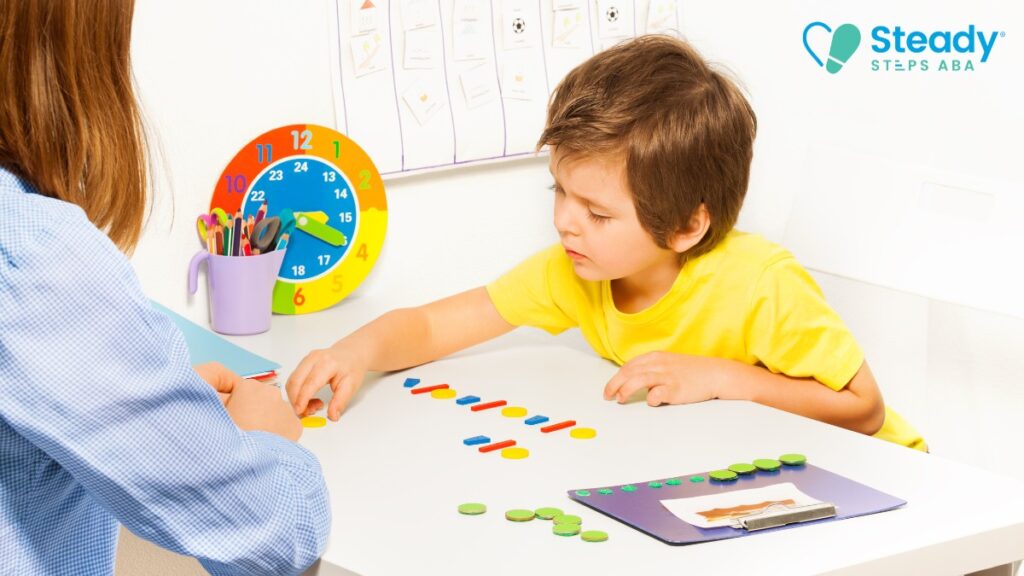Key Points:
- The duration of ABA therapy varies based on individual needs, goals, and progress.
- Therapy can range from several months to years, with programs often adjusted over time.
- Consistency and collaboration between therapists and families are key to achieving lasting outcomes.
When it comes to supporting children with autism spectrum disorder (ASD), every parent wants to know what to expect—and one of the biggest questions is about time. How long will ABA therapy last?
It’s a valid question, especially when thinking about your child’s progress and what it takes to achieve their goals. ABA therapy, a proven method for building essential social, communication, and behavioral skills, varies in duration based on individual needs.
By understanding how therapy plans are tailored and what factors influence the length of treatment, you’ll be better equipped to make informed decisions for your child’s journey. Let’s explore what goes into determining the duration of ABA therapy and how it can evolve over time.
Understanding the Duration of ABA Therapy
Applied Behavior Analysis (ABA) therapy is a widely recognized and effective intervention for children with autism spectrum disorder (ASD). According to the Centers for Disease Control and Prevention (CDC), about 1 in 36 children in the United States are diagnosed with ASD.
ABA therapy aims to improve social, communication, and behavioral skills through structured and evidence-based approaches. But one of the most common questions parents have is: how long does ABA therapy last?
How Long Does ABA Therapy Last?
The duration of ABA therapy depends on several factors, including the child’s needs, goals, and response to treatment. Programs may last anywhere from several months to several years.
Many families find that long-term therapy, often 1-3 years, is needed to achieve significant progress and generalization of skills.
For example:
- Intensive programs may require 25-40 hours per week over a couple of years.
- Focused programs addressing specific skills might involve fewer hours over a shorter period.
- Maintenance or follow-up sessions may occur less frequently once initial goals are met.
Factors Influencing the Duration of ABA Therapy
The length of ABA therapy is not one-size-fits-all. Below are the main factors that influence how long a child may need therapy:
- The Child’s Unique Needs
Every child with ASD has different strengths and challenges. Some children may require support in multiple areas, such as communication, social skills, and daily living tasks. Others may need help with specific behaviors.
- Age at the Start of Therapy
Starting therapy early often leads to quicker progress. Early intervention, ideally before age 5, can help lay the foundation for essential skills. However, ABA therapy is effective for older children and adolescents as well.
- Intensity of the Program
- Comprehensive programs: These typically involve 25-40 hours per week and focus on a wide range of skills. Comprehensive programs often span several years.
- Focused programs: These target specific goals and require fewer hours, such as 10-20 hours per week. They may last 6-12 months.
- Progress Over Time
Therapists regularly assess progress and adjust the program as needed. Faster progress may reduce the length of therapy, while slower progress might extend it.

What Does ABA Therapy Involve Over Time?
Initial Assessment and Goal Setting
ABA therapy begins with a comprehensive assessment to identify strengths, challenges, and areas for improvement. Goals are then tailored to the child’s developmental level.
Implementation of Therapy
Therapists use strategies such as positive reinforcement, prompting, and modeling to teach desired behaviors. Sessions are often conducted at home, in clinics, or in community settings.
Ongoing Monitoring and Adjustments
Progress is tracked using data, and goals are modified as the child’s needs evolve. This ensures the therapy remains effective and relevant.
Generalization and Maintenance
Once skills are learned, the focus shifts to applying them in real-life situations. Follow-up sessions may help reinforce skills and address any new challenges.
Signs That ABA Therapy May Be Complete
Knowing when to conclude therapy is important. Here are some indicators:
- Goals Have Been Achieved: The child has met most or all treatment objectives.
- Skills Are Generalized: The child uses learned behaviors across various environments and situations.
- Reduced Need for Support: The child can function independently or with minimal assistance.
- Family and Educator Collaboration: Parents and teachers are equipped to reinforce skills without direct therapist involvement.
Common Questions About ABA Therapy Duration
Can ABA Therapy Be Short-Term?
Yes, focused programs can address specific issues in as little as 6-12 months. However, for comprehensive skill development, longer durations are often necessary.
How Many Hours Per Week Is Ideal?
Most comprehensive programs recommend 25-40 hours per week, but the exact number depends on the child’s needs and family’s availability.
What Happens After ABA Therapy Ends?
After therapy, families may choose periodic consultations to ensure continued success. Some children transition to other supportive programs or school-based services.

The Importance of Consistency and Family Involvement
A critical aspect of ABA therapy is the role of parents and caregivers. Consistency across therapy sessions and daily routines helps reinforce learning. Parents often receive training to apply ABA techniques at home, fostering long-term success.
Ready to Begin ABA Therapy in Maryland?
At Steady Steps ABA, we understand that every child’s journey is unique. Our personalized ABA therapy programs in Maryland are designed to meet your child’s needs and help them thrive. Whether you’re seeking intensive support or focused skill development, we’re here to guide you every step of the way.
If you’re in Maryland and ready to explore how ABA therapy can benefit your child, contact us today to schedule a consultation. Let’s take steady steps toward a brighter future!



